CORDOBA IN ONE DAY TOP ATTRACTIONS ITINERARY
The Best of Córdoba in One Day
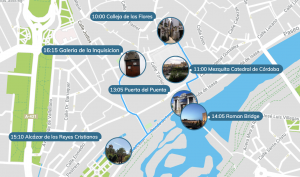 See the best of Cordoba in one day with this well planned itinerary. With this itinerary you will see the top attractions like the Mezquita Catedral de Cordoba with its 8th century Islamic architecture. Also see the quaint Calleja de los Flores, a narrow lane lined with hanging flower pots. Explore the historical center of Cordoba and see the Puerta del Puente and the romantic Roman Bridge. See the ancient Alcazar de los Reyes Cristianos.
See the best of Cordoba in one day with this well planned itinerary. With this itinerary you will see the top attractions like the Mezquita Catedral de Cordoba with its 8th century Islamic architecture. Also see the quaint Calleja de los Flores, a narrow lane lined with hanging flower pots. Explore the historical center of Cordoba and see the Puerta del Puente and the romantic Roman Bridge. See the ancient Alcazar de los Reyes Cristianos.Calleja de las Flores
Little Flower Street
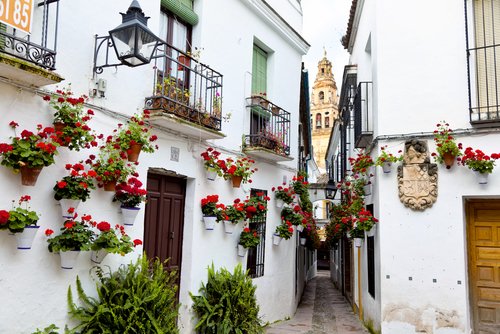 This quaint alley way is located in the Jewish Quarter of Cordoba, in front of the northern façade of the Mosque and leads into a small plaza. From the plaza there are great views of the Cathedral tower. The street has become popular with tourists for its beautiful white washed houses on either side with colorful flower baskets hanging from the windows and walls. The houses have charming balconies with wrought-iron balustrades dripping with flower pots. It is the picture-perfect vision of a typical Andalusian street. The street twists and winds up a gentle slope to the small square at the top. The homes along the Little Street of Flowers have beautiful little courtyards which the inhabitants take great pride in maintaining. One of the best times to visit the alley is during the festival de los Patios held in May.
This quaint alley way is located in the Jewish Quarter of Cordoba, in front of the northern façade of the Mosque and leads into a small plaza. From the plaza there are great views of the Cathedral tower. The street has become popular with tourists for its beautiful white washed houses on either side with colorful flower baskets hanging from the windows and walls. The houses have charming balconies with wrought-iron balustrades dripping with flower pots. It is the picture-perfect vision of a typical Andalusian street. The street twists and winds up a gentle slope to the small square at the top. The homes along the Little Street of Flowers have beautiful little courtyards which the inhabitants take great pride in maintaining. One of the best times to visit the alley is during the festival de los Patios held in May.
Mezquita Catedral de Córdoba
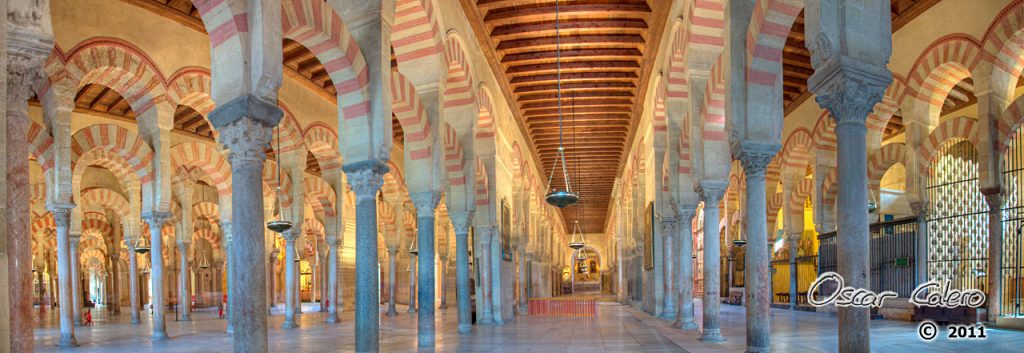 In the Mosque Cathedral or Cathedral of St. Mary of the Assumption of Cordoba we can trace many of the significant changes that have occurred in Cordoba’s religious history. The majority of the art and architecture we see today comes from the 8th century Islamic architects of the former mosque. As far back as the Romans this location was considered holy and the Romans constructed a temple here to Janus. Later a Visigothic cathedral stood here and then came the mosque. The Christian church was built inside the mosque by the Christian conquerors in the 13th century.
In the Mosque Cathedral or Cathedral of St. Mary of the Assumption of Cordoba we can trace many of the significant changes that have occurred in Cordoba’s religious history. The majority of the art and architecture we see today comes from the 8th century Islamic architects of the former mosque. As far back as the Romans this location was considered holy and the Romans constructed a temple here to Janus. Later a Visigothic cathedral stood here and then came the mosque. The Christian church was built inside the mosque by the Christian conquerors in the 13th century.
The original mosque structure took more than 200 years to complete; it was begun in 784AD and is said to have held an original copy of the Koran and relics of the Prophet Mohammed. In the 9thcentury a minaret was added and in 961 the structure was enlarged. Outer aisles and the orange tree courtyard were completed in 987. Each wave of conquering invaders left their mark on the building including King Alfonso X who had the Villaviciosa Chapel and the Royal Chapel constructed; Enrique II rebuilt the chapel in the14th century; under Carlos V a new nave was built; the Baroque choir was an addition in the 1520s by Charles V and changes continued into the late 18th century.
The Mosque Cathedral has breathtaking arches supported by 856 columns (originally 1,293) made of precious stone and marble. Some of the marble used came from the earlier Roman temple which stood here. In the prayer niches there is rich gilding and the mihrab is a domed shrine with exquisite Byzantine mosaics. In the Maksoureh anteroom there are Islamic mosaics and plasterwork. The Baroque choir seems out of place in the mosque but it also has architectural features worth seeing like the carved choir stalls and beautiful ceiling. Patio de los Naranjos is a courtyard with orange trees and a fountain. The Torre del Alminar was once the minaret but became the cathedral belfry and it is possible to climb to the top for views over Cordoba.
Historical Center of Cordoba
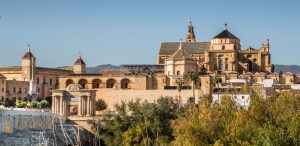 Cordoba’s “golden years” began in the 8th century after the Moors had conquered the city and established about 300 mosques, palaces and public buildings. They built intricately designed and decorated structures to rival even those of Constantinople and Damascus. Under Ferdinand III the Saint in the 13th century more magnificent buildings were constructed like the Alcazar de los Reyes Cristianos, Torre Fortaleza de la Calahorra and the Great Mosque was converted into a Cathedral. The historical center of Cordoba has been classified as a UNESCO World Heritage Site for “universal value.” It comprises the area surrounding the Cathedral-Mosque, extending across the river to include the Roman Bridge and Calahorra. The area extends to the Calle San Fernando in the east, the commercial center in the north and the San Basilio Quarter in the west. The historical center of the city illustrates the different cultures which have lived here, the city’s relationship with the river and as important port-of-call between the south and meseta (central plateau of Spain). The best way to explore the historic center of Cordoba is to discover the narrow lanes and historic sites on foot.
Cordoba’s “golden years” began in the 8th century after the Moors had conquered the city and established about 300 mosques, palaces and public buildings. They built intricately designed and decorated structures to rival even those of Constantinople and Damascus. Under Ferdinand III the Saint in the 13th century more magnificent buildings were constructed like the Alcazar de los Reyes Cristianos, Torre Fortaleza de la Calahorra and the Great Mosque was converted into a Cathedral. The historical center of Cordoba has been classified as a UNESCO World Heritage Site for “universal value.” It comprises the area surrounding the Cathedral-Mosque, extending across the river to include the Roman Bridge and Calahorra. The area extends to the Calle San Fernando in the east, the commercial center in the north and the San Basilio Quarter in the west. The historical center of the city illustrates the different cultures which have lived here, the city’s relationship with the river and as important port-of-call between the south and meseta (central plateau of Spain). The best way to explore the historic center of Cordoba is to discover the narrow lanes and historic sites on foot.
Cordoba’s Historical Center is one of the largest in Europe; you can see evidence of various periods of history within this one area. Sites within the historic center include the Roman Bridge over the River Guadalquivir; Alcazar with its magnificent mosaics; the Roman temple; remains of the Roman walls; Caliphal Baths; Grand Mosque; Chapel of San Bartolome; San Pelagio Seminary; Puerta del Puente; Palacio del Marques de la Fuensanta del Valle; Hospital del Cardenal Zalazar; Episcopal Palace; San Lorenzo; Royal Stables; Santa Clara Hermitage and the Jewish District where the historic synagogue stands.
Puerta del Puente
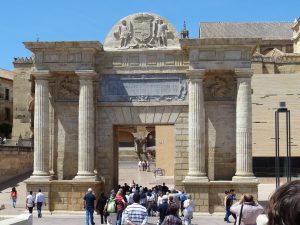 The Bridge Gate stands on the north bank of the River and the present Renaissance structure was constructed on the site of former Roman and Moorish gates. First mention of the gate in historic documents was is 720AD when it was restored. The gate joins the old town to the Roman Bridge and at one point would have been the entry gate to the city and part of the city walls. The present structure was commissioned by the city governor in 1572 and created by architect Hernan Ruiz III to mark the visit of Felipe II. Today it stands on a traffic island. The design features a central square entrance and on either side are pairs of Doric columns supporting a classic-style entablature. The public can visit the gate and see a permanent exhibition illustrating the history of the gate through images and texts. You can also climb to the top of the gate for views across the city.
The Bridge Gate stands on the north bank of the River and the present Renaissance structure was constructed on the site of former Roman and Moorish gates. First mention of the gate in historic documents was is 720AD when it was restored. The gate joins the old town to the Roman Bridge and at one point would have been the entry gate to the city and part of the city walls. The present structure was commissioned by the city governor in 1572 and created by architect Hernan Ruiz III to mark the visit of Felipe II. Today it stands on a traffic island. The design features a central square entrance and on either side are pairs of Doric columns supporting a classic-style entablature. The public can visit the gate and see a permanent exhibition illustrating the history of the gate through images and texts. You can also climb to the top of the gate for views across the city.
Roman Bridge
Puente Romano
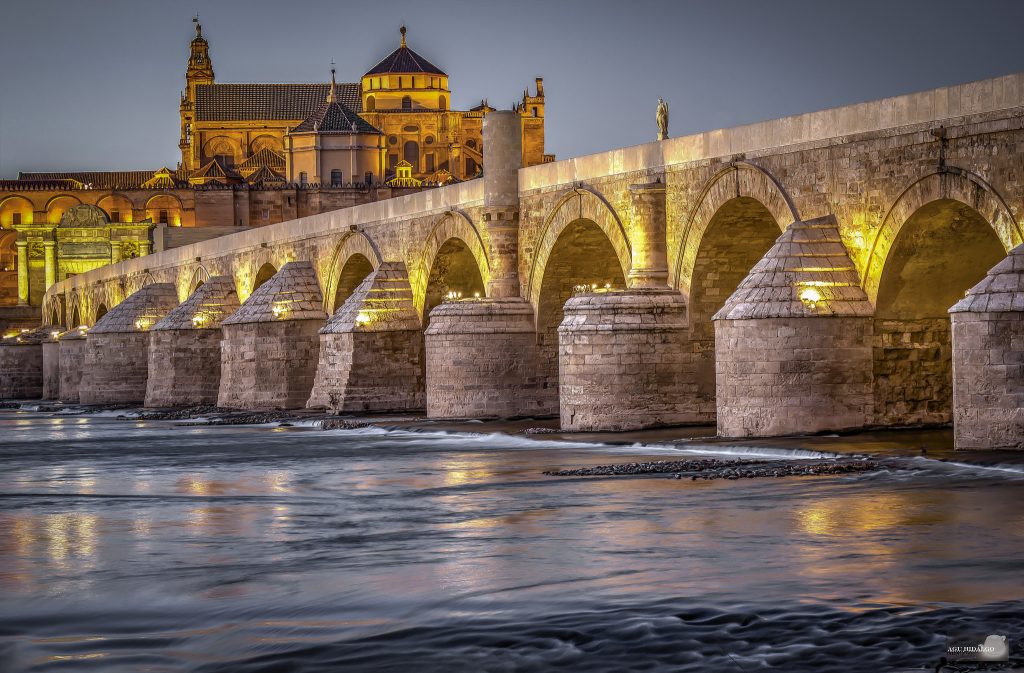 Puente Romano crosses the Guadalquivir River, it originated in the 1st century AD but has been rebuilt several times since then. The Roman Bridge would have been part of the Augusta route which connected Roma to Cadiz. Its present form was constructed in the Middle Ages, with the Muslim rulers building on the remains of the former Roman Bridge. The Puerta del Puente and Calahorra Tower were constructed at each end of the bridge in the Middle Ages. The latest changes were made in 1876. The bridge has 16 arches (the original had 17 arches), four are pointed and the rest are semi-circular. Half-way along the bridge is a 16th century shrine and statue of Saint Raphael created by Bernabe Gomez del Rio. The total length of the bridge is 247 meters and it is approximately 9 meters wide.
Puente Romano crosses the Guadalquivir River, it originated in the 1st century AD but has been rebuilt several times since then. The Roman Bridge would have been part of the Augusta route which connected Roma to Cadiz. Its present form was constructed in the Middle Ages, with the Muslim rulers building on the remains of the former Roman Bridge. The Puerta del Puente and Calahorra Tower were constructed at each end of the bridge in the Middle Ages. The latest changes were made in 1876. The bridge has 16 arches (the original had 17 arches), four are pointed and the rest are semi-circular. Half-way along the bridge is a 16th century shrine and statue of Saint Raphael created by Bernabe Gomez del Rio. The total length of the bridge is 247 meters and it is approximately 9 meters wide.
Visitors can walk across the bridge or get good photo ops from the south bank. If you start on the south bank near Avenida Fray Albino and walk across the bridge you will see the Bridge Gate and reach the old town and Mosque-Cathedral on the opposite bank of the river. The bridge was featured in the 5th season of the TV series Game of Thrones as the Long Bridge of Volantis.
Alcázar de los Reyes Cristianos
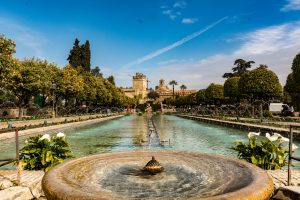 The ancient fortress of Alcazar of the Christian Monarchs or Alcazar of Cordoba served as the court of royals for 160 years following its constructed by Alfonso XI in 1328. The complex stands on the site on an earlier 8th century caliphate residence and still retains elements of the Moorish remains. During the 15th century the complex was home to Ferdinand and Isabella, rulers of Castile for 8 years while planning their attack on Granada to oust the last of the Moors. This is where Christopher Columbus was presented to Queen Isabella and told of his plans to discover the New World. This complex also once held Boabdil (Moorish ruler of Granada) prisoner in 1483 and a few years later became the headquarters of the Spanish Inquisition (1492-1821) and was used as a prison. In 1810 the palace –fortress became the garrison for Napoleon’s forces.
The ancient fortress of Alcazar of the Christian Monarchs or Alcazar of Cordoba served as the court of royals for 160 years following its constructed by Alfonso XI in 1328. The complex stands on the site on an earlier 8th century caliphate residence and still retains elements of the Moorish remains. During the 15th century the complex was home to Ferdinand and Isabella, rulers of Castile for 8 years while planning their attack on Granada to oust the last of the Moors. This is where Christopher Columbus was presented to Queen Isabella and told of his plans to discover the New World. This complex also once held Boabdil (Moorish ruler of Granada) prisoner in 1483 and a few years later became the headquarters of the Spanish Inquisition (1492-1821) and was used as a prison. In 1810 the palace –fortress became the garrison for Napoleon’s forces.
The palace-fortress complex sits on the bank of the Cordoba River and was designed in the Mudejar style. It is a quadrangular structure covering 4,100m² and completely surrounded by thick walls with three towers (there used to be four). In the Tower of the Lions there are cross-vaulted ceiling, two floors and a roof top terrace with battlements. The circular Tower of Inquisition has ashlar blocks on the exterior each laid in a different direction. The final tower is an octagonal structure and served as the castle keep or homage. The top floor’s Reception Hall has a Gothic ogival ceiling and above is a smaller raised tower where inquisition executions took place.
The Alcazar houses beautiful Roman mosaics in the former Chapel of the Inquisition; a Moorish bathhouse and several sarcophagi from the 2nd-3rd century. In the Romero de Torres you can see magnificent 16th century frescoes. In the Moorish patio there is Stucco work at the base of the walls with castle and lion motifs. The lush gardens (Paseo de los Reyes) cover 55,000m² and surround the buildings. Here you can see statues of the former kings associated with the fortress. The gardens are adorned with fountains, manicured hedges, ponds and landscaped gardens. Alongside the gardens stand the Royal Stables.




No Comments